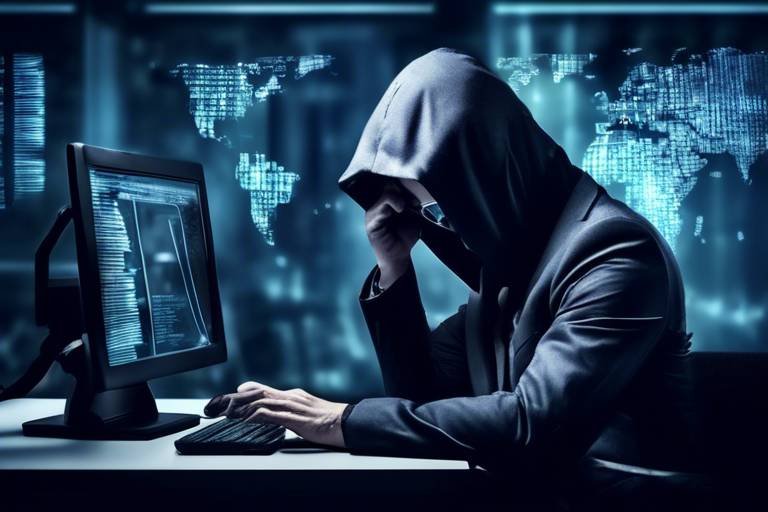How to Secure Your Personal Email
In today's digital landscape, securing your personal email is more important than ever. With cyber threats lurking around every corner, it’s crucial to take proactive steps to protect your sensitive information. Think of your email as your digital front door; if it's not locked and fortified, anyone can waltz right in. This article explores essential strategies and best practices for safeguarding your personal email account from unauthorized access and potential threats, ensuring your privacy and security in the digital age.
Identifying common vulnerabilities in email systems is crucial for enhancing security. There are various threats that can compromise personal email accounts, including phishing attacks, malware, and weak passwords. Phishing scams often masquerade as legitimate emails, tricking you into providing sensitive information. Malware, on the other hand, can infiltrate your system through malicious attachments or links. Weak passwords are like leaving your front door ajar; they make it easy for cybercriminals to gain access. Understanding these vulnerabilities is the first step in fortifying your email defenses.
A strong password is your first line of defense against unauthorized access. So, what makes a password strong? It should be a mix of uppercase and lowercase letters, numbers, and special characters. Ideally, your password should be at least 12 characters long. Think of your password as a shield; the stronger it is, the better it can protect you. Additionally, it’s essential to change your passwords regularly. Just like you wouldn’t wear the same shoes every day, you shouldn’t use the same password for an extended period. Regular updates can significantly reduce the risk of your account being compromised.
Password managers can help you generate and store complex passwords securely. These tools work by creating unique passwords for each of your accounts and storing them in an encrypted vault. This way, you only need to remember one master password. The benefits are immense; not only do they save you time, but they also enhance your security by ensuring that you don’t reuse passwords across multiple sites. Imagine having a personal vault for all your important keys—password managers offer that level of security for your online accounts.
Two-factor authentication (2FA) adds an extra layer of protection to your email account. By requiring not only your password but also a second form of identification, such as a text message or an authentication app, it significantly reduces the risk of unauthorized access. Think of it as having a bouncer at your digital door; even if someone has your password, they still can’t get in without that second key. Enabling 2FA can make a world of difference in your email security.
Selecting secure recovery options is vital for account recovery. When setting up recovery emails and phone numbers, make sure they are secure and not easily accessible to others. For instance, avoid using an email address that is publicly available. Instead, opt for a trusted email account that you regularly monitor. This precaution ensures that if you ever need to recover your account, you can do so without falling into the hands of cybercriminals.
Phishing scams are common tactics used by cybercriminals to steal information. To avoid falling victim to these scams, educate yourself on how to identify suspicious emails. Look for telltale signs such as poor grammar, urgent requests for personal information, and unfamiliar sender addresses. If something feels off, it probably is. Always double-check the sender’s email address and hover over links to see their true destination before clicking. Think of it as a game of “spot the fake”—the more aware you are, the better you can protect yourself.
Regularly updating your software can prevent security vulnerabilities. Software developers frequently release updates to patch security holes that could be exploited by hackers. Failing to keep your email client and operating system up-to-date is like leaving a window open in a storm. Make it a habit to check for updates regularly and enable automatic updates whenever possible. This simple action can significantly enhance your email security and protect you from emerging threats.
Establishing secure connections is essential for email safety. Always use HTTPS when accessing your email, as it encrypts the data being transmitted. Additionally, consider using a Virtual Private Network (VPN) when accessing your email on public Wi-Fi. This adds an extra layer of security, making it harder for hackers to intercept your data. Think of it as wrapping your email in a protective bubble whenever you’re online.
Monitoring your email account for unusual activity can help detect unauthorized access early. Most email providers offer features that allow you to review recent account activity. Keep an eye out for unfamiliar logins or changes to your account settings. If you notice anything suspicious, act quickly—change your password, enable 2FA, and consider notifying your email provider. By staying vigilant, you can catch potential threats before they escalate into serious issues.
- What is the best way to create a strong password? A strong password should be at least 12 characters long and include a mix of letters, numbers, and symbols.
- How often should I change my password? It's advisable to change your password every 3 to 6 months.
- What should I do if I suspect my email has been compromised? Change your password immediately, enable two-factor authentication, and review your account activity for any unauthorized changes.

Understanding Email Vulnerabilities
In today's digital landscape, understanding the vulnerabilities associated with email is more crucial than ever. Email is a primary mode of communication for both personal and professional interactions, making it a prime target for cybercriminals. The threats can come in various forms, and recognizing these vulnerabilities is the first step toward effectively safeguarding your personal email account.
One of the most prevalent threats is phishing attacks. These are deceptive emails that appear to come from legitimate sources, tricking users into providing sensitive information such as passwords or financial details. For instance, you might receive an email that looks like it’s from your bank, urging you to click a link to verify your account. In reality, that link could lead to a fraudulent website designed to steal your information. It’s essential to be vigilant and scrutinize every email, especially those requesting personal data.
Another significant risk comes from malware. This malicious software can infiltrate your system through infected email attachments or links. Once installed, malware can compromise your personal data, track your online activities, or even take control of your device. Always be cautious about opening attachments or clicking on links from unknown senders, as they could be gateways for malware.
Moreover, using weak passwords is like leaving your front door wide open. Many people still opt for simple passwords that are easy to remember but also easy for hackers to guess. A strong password should be a mix of uppercase and lowercase letters, numbers, and special characters. It’s also wise to avoid using easily obtainable information, such as birthdays or names, as these can be easily guessed by cybercriminals.
To put things into perspective, let’s consider a few common email vulnerabilities:
- Phishing Attacks: Deceptive emails designed to steal personal information.
- Malware: Malicious software that can compromise your device and data.
- Weak Passwords: Easily guessable passwords that leave your account exposed.
Understanding these vulnerabilities is not just about recognizing them; it’s about taking proactive measures to protect yourself. By being aware of the threats and implementing security best practices, you can significantly reduce your risk of falling victim to email-related attacks. Remember, in the world of cybersecurity, knowledge is power. The more you know about potential threats, the better equipped you are to defend against them.

Choosing Strong Passwords
When it comes to securing your personal email, is absolutely essential. Think of your password as the key to your digital house; if it’s weak or easily guessed, you might as well leave the door wide open for intruders. So, how do you create a password that stands strong against the relentless attacks of cybercriminals? First, you need to understand what makes a password strong. A robust password typically includes a mix of uppercase and lowercase letters, numbers, and special characters. The longer the password, the better—aim for at least 12 to 16 characters.
One common mistake people make is using easily accessible information, such as birthdays or pet names, in their passwords. This is like putting your name on your front door; it makes it too easy for someone to break in. Instead, consider using a passphrase, which is a series of random words strung together. For example, “BlueSky!Dancing@42” is not only memorable but also much harder to crack than a standard word. You can even make it personal by incorporating elements that are meaningful to you, but avoid anything that could easily be found on social media.
Another tip is to change your passwords regularly. Just like you wouldn’t want to wear the same shoes every day, you shouldn’t rely on the same password for too long. Set a reminder to update your passwords every few months. This practice can significantly reduce the chances of unauthorized access, especially if a data breach occurs somewhere else.
To make this process easier, consider using a password manager. These tools not only help you generate complex passwords but also store them securely, so you don’t have to remember every single one. Imagine having a personal vault that keeps all your keys safe and sound—password managers do just that! They can save you time and stress, allowing you to focus on other important things in your life.
In summary, choosing strong passwords is a fundamental step in protecting your personal email. By creating unique, complex passwords, changing them regularly, and utilizing password managers, you can significantly enhance your email security. Remember, your password is your first line of defense, so treat it with the seriousness it deserves!

Utilizing Password Managers
In today's fast-paced digital world, managing multiple accounts can feel like a juggling act. With so many platforms requiring unique credentials, it's no wonder that people often resort to using simple passwords or, worse, the same password across multiple sites. This is where password managers come into play, serving as a knight in shining armor for your online security. These tools not only help you generate complex passwords but also store them securely, allowing you to focus on what truly matters without the constant worry of forgetting your credentials.
Password managers work by encrypting your passwords and storing them in a secure vault. When you need to log into a site, you simply access your password manager, and it fills in the credentials for you. This means you can create strong, unique passwords for each of your accounts without the hassle of remembering them all. Imagine having a personal assistant who remembers every single password you’ve ever created—sounds like a dream, right?
One of the key benefits of using a password manager is the ability to generate robust passwords that are nearly impossible to crack. Most password managers come equipped with a password generator, allowing you to create passwords that are a mix of letters, numbers, and symbols. Here’s a quick look at how a password manager can enhance your security:
| Feature | Benefit |
|---|---|
| Strong Password Generation | Creates complex passwords that are hard to guess. |
| Secure Storage | Encrypts your passwords to keep them safe from hackers. |
| Auto-fill Capability | Simplifies the login process by filling in credentials automatically. |
| Cross-Device Syncing | Access your passwords on multiple devices seamlessly. |
Moreover, password managers often include additional features such as security audits, which analyze your stored passwords to identify weak or reused ones. This proactive approach allows you to enhance your security posture continuously. It's like having a personal trainer for your passwords, ensuring that they remain in peak condition!
However, it’s essential to choose a reputable password manager. Look for one that offers strong encryption, a user-friendly interface, and positive reviews from trusted sources. While no system is foolproof, utilizing a password manager significantly reduces the risk of falling victim to common password-related vulnerabilities.
In conclusion, embracing a password manager is a smart step towards securing your personal email and other online accounts. By simplifying password management, these tools enable you to maintain high security without the mental burden of remembering complex passwords. So why not give yourself the gift of peace of mind? Start exploring password managers today and take control of your digital security!

Benefits of Two-Factor Authentication
In an era where cyber threats loom large, two-factor authentication (2FA) has emerged as a vital shield for your personal email account. Imagine your email as a fortress; a strong password is the gate, but 2FA adds a moat filled with alligators! This extra layer of security requires not just something you know (your password) but also something you have (like your smartphone). By implementing 2FA, you’re essentially doubling the effort required for any would-be intruder to access your account, making it significantly harder for them to succeed.
One of the primary benefits of two-factor authentication is its ability to thwart the most common form of cyberattacks: credential stuffing and phishing. Even if a hacker manages to steal your password through a phishing email, they still face the daunting task of bypassing the second factor. This could be a text message with a code sent to your phone or a prompt from an authentication app. The result? Your email remains secure, and your sensitive information stays safe. It's like having a second lock on your door that only you have the key to!
Moreover, 2FA not only protects your email but also enhances the security of other accounts linked to the same email address. Many services, such as social media platforms and financial institutions, offer 2FA options. By enabling this feature across multiple accounts, you create a network of security that is incredibly difficult for attackers to breach. Think of it as not just reinforcing one door but fortifying every entry point into your digital life.
Here are some key benefits of using two-factor authentication:
- Enhanced Security: Even if your password is compromised, your account remains protected.
- Reduced Risk of Identity Theft: By making it harder for attackers to access your account, you lower the chances of them stealing your personal information.
- Peace of Mind: Knowing that you have an additional layer of security allows you to use your email with confidence.
In conclusion, enabling two-factor authentication is one of the simplest yet most effective steps you can take to secure your personal email. It’s a small inconvenience for a big payoff in security. So, if you haven’t already, take a moment to turn on 2FA for your email and other important accounts. It’s like adding an extra layer of armor to your digital presence, ensuring that your information stays safe from prying eyes.

Choosing Secure Recovery Options
When it comes to securing your personal email account, choosing the right recovery options is just as important as creating a strong password. Why, you ask? Because recovery options are your lifeline in case you ever get locked out of your account or if someone tries to take control of it. Imagine losing access to your email and all the important information it holds—like your bank statements, personal correspondence, and even your social media accounts. It's a nightmare scenario, but it can be avoided with a little foresight.
To begin with, you should always choose a recovery email address that is secure and not easily accessible to others. This could be another personal email account that you rarely use or an email from a different provider. The key is to ensure that this recovery email is not linked to the same security vulnerabilities as your primary account. For instance, if your main email is compromised, you don’t want the recovery email to be easily hacked as well.
Additionally, consider using a trusted phone number for recovery. This could be your mobile number or a family member's number that you trust. But remember, it’s crucial to keep this number updated; if you change your phone or number, make sure to update it in your email settings promptly. The last thing you want is to be locked out of your account because you forgot to update your recovery options.
Here are some best practices to keep in mind when setting up your recovery options:
- Use Different Providers: If your primary email is with one provider, consider using a different provider for your recovery email.
- Enable Notifications: Set up notifications for any changes made to your recovery options, so you're alerted if someone attempts to alter them.
- Regularly Review: Periodically check your recovery options to ensure they are current and secure.
Lastly, don’t overlook the importance of security questions. If your email provider offers security questions, choose ones that are not easily guessable. Avoid common questions like your mother's maiden name or the name of your first pet, as these can often be found on social media or guessed by someone who knows you. Instead, opt for questions that are personal and unique to you.
By taking the time to carefully choose and regularly update your recovery options, you can significantly enhance the security of your personal email account. It’s like having a backup key to your house—if you lose the main key, you’ll still have a way in, but only if that backup is safe and secure.
Q: What should I do if I can't access my recovery email?
A: If you can't access your recovery email, try to recover it first. If that fails, contact the email provider's support for assistance.
Q: How often should I update my recovery options?
A: It's a good practice to review and update your recovery options at least once a year or whenever you change your phone number or email address.
Q: Can I use a friend’s email as a recovery option?
A: While it’s possible, it’s not recommended. You want to ensure that your recovery options are under your control to avoid any potential issues.

Recognizing Phishing Scams
In today's digital landscape, phishing scams have become alarmingly prevalent, and recognizing them is crucial for your email security. These scams often masquerade as legitimate communications, tricking users into revealing sensitive information like passwords, credit card details, and social security numbers. Imagine receiving an email that looks exactly like it’s from your bank, prompting you to click on a link to verify your account details. It’s a classic bait-and-switch tactic that can lead to devastating consequences. So, how do you spot these deceptive emails before they can do any harm?
First, always scrutinize the sender's email address. Phishing emails often come from addresses that may seem similar to legitimate ones but have slight variations or misspellings. For instance, instead of support@yourbank.com, it might be support@yourb4nk.com. This small difference can be easy to overlook but can make a significant difference in your security.
Next, pay close attention to the language and tone of the email. Legitimate organizations typically use formal language and clear communication. Phishing emails, on the other hand, may contain grammatical errors, awkward phrasing, or an urgent tone that pressures you to act quickly. If you feel rushed or uneasy about the content, take a step back and verify its authenticity.
Furthermore, be cautious of links and attachments. Hover over any links before clicking to see the actual URL. If it looks suspicious or doesn’t match the context of the email, don't click it. Additionally, avoid downloading attachments from unknown sources, as they may contain malware designed to compromise your device.
Here’s a quick checklist to help you recognize phishing scams:
- Check the sender's email address for discrepancies.
- Look for spelling and grammar mistakes in the message.
- Be wary of urgent requests for personal information.
- Hover over links to verify their destination before clicking.
- Avoid opening attachments from unknown senders.
Finally, if you ever receive a suspicious email, remember that you can always contact the organization directly using verified contact information (like their official website) instead of responding to the email. This way, you can confirm whether the email was legitimate without putting your information at risk.
Staying vigilant and informed about phishing tactics is your best defense against these scams. By recognizing the signs and practicing caution, you can protect your personal email and keep your sensitive information safe from cybercriminals.
Q: What should I do if I suspect I've fallen for a phishing scam?
A: Immediately change your passwords for any affected accounts, monitor your financial statements for unauthorized transactions, and report the phishing attempt to your email provider.
Q: Can antivirus software help with phishing scams?
A: Yes, many antivirus programs offer phishing protection features that can alert you to suspicious emails and websites.
Q: How can I educate others about phishing scams?
A: Share your knowledge with friends and family, discuss common signs of phishing, and encourage them to be cautious with their personal information.

Keeping Software Updated
In today's fast-paced digital world, keeping your software updated is more crucial than ever. Think of your email account as a house; if you don't regularly check for cracks in the walls or replace the locks, you're inviting trouble. Software updates are like those home repairs—necessary to keep out intruders and maintain your security. When software developers release updates, they often include patches that fix vulnerabilities that hackers could exploit. Ignoring these updates is akin to leaving your front door wide open, making it easy for cybercriminals to waltz right in.
Regular updates not only enhance security but also improve functionality and performance. For example, an updated email client may introduce new features that make your experience smoother and more efficient. Plus, updates often come with bug fixes that can prevent annoying glitches that disrupt your work. So, why risk it? Embracing updates is a straightforward way to fortify your defenses against potential threats.
Here are some common types of software that should be kept updated:
- Email Clients: Whether you're using Outlook, Thunderbird, or a web-based service, make sure your email client is always up to date.
- Operating Systems: Your computer's operating system, be it Windows, macOS, or Linux, is the backbone of your device's security.
- Antivirus Software: Keeping your antivirus software current ensures that you have the latest virus definitions and protection methods.
- Browsers: Web browsers are often the gateway to your email. Keeping them updated helps protect against phishing and malware.
To make things easier, many software applications offer automatic updates. This feature allows your software to update itself without requiring your intervention. However, you should still check periodically to ensure that automatic updates are functioning correctly. If you prefer a more hands-on approach, consider setting reminders to check for updates weekly or monthly. This way, you can stay proactive rather than reactive when it comes to your digital security.
In summary, keeping your software updated is a simple yet effective way to enhance your email security. By regularly updating your email client, operating system, antivirus software, and web browser, you’re not just patching vulnerabilities; you’re also ensuring that your digital life runs smoothly. Remember, the cost of neglecting updates can be far greater than the time it takes to install them. So, roll up your sleeves and give your software the attention it deserves!
Q: How often should I update my software?
A: Ideally, you should check for updates at least once a month or enable automatic updates to ensure you always have the latest security patches.
Q: What happens if I ignore software updates?
A: Ignoring updates can leave your software vulnerable to security breaches, malware, and other threats, potentially compromising your personal information.
Q: Are automatic updates safe?
A: Yes, automatic updates are generally safe and recommended, as they ensure you receive the latest security patches and improvements without manual intervention.

Using Secure Connections
In today's digital landscape, ensuring that your email communications are secure is of utmost importance. One of the most effective ways to achieve this is by when accessing your email. But what does that really mean? Essentially, it involves utilizing protocols and technologies that encrypt your data, making it significantly harder for cybercriminals to intercept or access your information.
One of the primary methods to establish a secure connection is through the use of HTTPS (Hypertext Transfer Protocol Secure). When you see "https://" in your browser's address bar instead of "http://", it indicates that the connection is encrypted. This encryption protects the data transmitted between your browser and the email server, ensuring that any sensitive information remains confidential. Always make sure that your email provider supports HTTPS and that you are accessing your email through a secure URL.
Another layer of security can be added by using a Virtual Private Network (VPN). A VPN creates a secure tunnel between your device and the internet, which is especially useful when you’re on public Wi-Fi networks, like at a coffee shop or airport. Public networks are notorious for being unsecured, making it easy for hackers to intercept data. By using a VPN, you can encrypt your internet connection and shield your email communications from prying eyes. So, next time you're checking your emails on a public network, consider connecting to a VPN first.
Moreover, it’s essential to be aware of the risks associated with unsecured connections. For instance, when you access your email without a secure connection, you expose yourself to various threats, including man-in-the-middle attacks. In these scenarios, an attacker can intercept the communication between you and your email server, potentially gaining access to your sensitive information. Therefore, always prioritize secure connections to protect your personal data.
In summary, using secure connections is a fundamental practice for safeguarding your email. By ensuring that you access your email through HTTPS and utilizing a VPN, you can significantly reduce the risk of unauthorized access and keep your personal information safe. Remember, in the world of cybersecurity, being proactive is key to protecting your digital life.
- What is HTTPS and why is it important?
HTTPS is a secure version of HTTP. It encrypts the data exchanged between your browser and the website, making it crucial for protecting sensitive information.
- How does a VPN enhance my email security?
A VPN encrypts your internet connection, especially on public Wi-Fi, making it difficult for hackers to intercept your data.
- Can I check my email securely on public Wi-Fi?
Yes, but you should always use a VPN to ensure that your connection is secure and your data is protected.

Regularly Monitoring Account Activity
In today's digital landscape, where cyber threats lurk around every corner, regularly monitoring your email account activity is not just a good practice; it's a necessity. Think of your email as a digital bank account—would you leave your bank statements unchecked for months? Probably not! Just like you would keep an eye on your finances, you should also keep tabs on your email to catch any suspicious actions before they escalate into serious issues.
So, what should you be looking for when you check your account activity? Start by looking for any unusual login attempts. Most email providers offer a way to view recent logins, showing you the IP addresses and locations from which your account has been accessed. If you notice a login from a location you don't recognize, it could be a red flag indicating that someone else is trying to access your account.
Another key aspect of monitoring is to keep an eye on your sent and received emails. Are there emails in your "Sent" folder that you didn't send? Or maybe you see some strange replies in your inbox? These can be clear indicators that your account has been compromised. If you find anything that looks suspicious, it's crucial to act quickly—change your password immediately and notify your email provider.
To make the monitoring process more manageable, consider setting reminders to check your account activity regularly. You might want to do this weekly or bi-weekly. Keeping a routine can help you stay on top of any potential threats. Additionally, many email services now offer security alerts that notify you of any unusual activity. Make sure to enable these alerts so you're informed in real time.
Here’s a quick reference table to illustrate what to look for during your monitoring sessions:
| Activity Type | What to Look For | Action to Take |
|---|---|---|
| Unusual Logins | Logins from unfamiliar locations or devices | Change your password and enable two-factor authentication |
| Sent Emails | Emails you didn’t send | Change your password and check for malware |
| Security Alerts | Notifications of suspicious activity | Follow the instructions provided in the alert |
In conclusion, the importance of regularly monitoring your email account activity cannot be overstated. By staying vigilant, you can catch potential threats early and take action to protect your personal information. Remember, it's always better to be safe than sorry when it comes to your digital security!
- How often should I check my email account activity?
It's advisable to check your account activity at least once a week to catch any suspicious actions early. - What should I do if I find suspicious activity?
Immediately change your password, enable two-factor authentication, and notify your email provider. - Can I monitor my email activity on mobile devices?
Yes, most email apps offer features to view recent activity, but always ensure you have the latest version installed for security updates.
Frequently Asked Questions
- What are the most common email vulnerabilities?
Common email vulnerabilities include phishing attacks, where cybercriminals trick you into providing personal information, and weak passwords that can be easily guessed. Malware can also compromise your email by infecting your device, allowing hackers to access your accounts.
- How can I create a strong password?
To create a strong password, use a combination of uppercase letters, lowercase letters, numbers, and special characters. Aim for at least 12 characters and avoid using easily guessable information like birthdays or names. It's also a good idea to change your password regularly.
- What is a password manager and why should I use one?
A password manager is a tool that helps you generate, store, and manage complex passwords securely. By using a password manager, you can create unique passwords for each of your accounts without having to remember them all, greatly enhancing your security.
- What is two-factor authentication and how does it help?
Two-factor authentication (2FA) adds an extra layer of security by requiring not just a password but also a second form of verification, such as a text message or authentication app. This significantly reduces the risk of unauthorized access, even if your password is compromised.
- How can I recognize phishing scams?
To recognize phishing scams, look for suspicious email addresses, generic greetings, and urgent language that pressures you to act quickly. Always hover over links to see the actual URL before clicking and avoid downloading attachments from unknown sources.
- Why is it important to keep my software updated?
Keeping your software updated is crucial because updates often include security patches that protect against newly discovered vulnerabilities. Regular updates help ensure that your email client and operating system are equipped to handle emerging threats.
- What does it mean to use secure connections when accessing email?
Using secure connections means accessing your email over HTTPS or through a Virtual Private Network (VPN). This encrypts your data, making it much harder for hackers to intercept your information while you’re online.
- How can I monitor my email account for unusual activity?
To monitor your email account, regularly check your account activity and login history. Look for any suspicious logins or actions that you did not perform. If you notice anything unusual, change your password immediately and consider enabling two-factor authentication.



















